目的
異なるネットワークに所属している2台のPCをお互いに通信させます。
ルーティングプロトコルはRIPv1を使用します。
RIPの設定方法を学びます。
接続構成

コマンド
router rip
network ネットワークアドレス
RIPルーティングプロトコルを有効にします。
RIPを有効化するネットワークを指定します。
設定
R1の設定
R1(config)#int f0/0
R1(config-if)#ip add 192.168.1.1 255.255.255.0
R1(config-if)#no shut
R1(config-if)#int s0/0
R1(config-if)#ip add 192.168.2.1 255.255.255.0
R1(config-if)#no shut
R1(config)#router rip
R1(config-router)#network 192.168.1.0
R1(config-router)#network 192.168.2.0
R2の設定
R2(config)#int f0/0
R2(config-if)#ip add 192.168.3.1 255.255.255.0
R2(config-if)#no shut
R2(config-if)#int s0/0
R2(config-if)#ip add 192.168.2.2 255.255.255.0
R2(config-if)#no shut
R2(config)#router rip
R2(config-router)#net 192.168.2.0
R2(config-router)#net 192.168.3.0
PC-1の設定
PC-1> ip 192.168.1.100/24 192.168.1.1
Checking for duplicate address...
PC1 : 192.168.1.100 255.255.255.0 gateway 192.168.1.1
PC-1> save
Saving startup configuration to startup.vpc
. done
PC-2の設定
PC-2> ip 192.168.3.100/24 192.168.3.1
Checking for duplicate address...
PC1 : 192.168.3.100 255.255.255.0 gateway 192.168.3.1
PC-2> save
Saving startup configuration to startup.vpc
. done
設定確認
ルーティングプロトコルの確認
R1#sh ip protocols
Routing Protocol is "rip" ①
Sending updates every 30 seconds, next due in 18 seconds
Invalid after 180 seconds, hold down 180, flushed after 240
Outgoing update filter list for all interfaces is not set
Incoming update filter list for all interfaces is not set
Redistributing: rip
Default version control: send version 1, receive any version
Interface Send Recv Triggered RIP Key-chain
FastEthernet0/0 1 1 2
Serial0/0 1 1 2
Automatic network summarization is in effect
Maximum path: 4
Routing for Networks:
192.168.1.0 ②
192.168.2.0
Routing Information Sources:
Gateway Distance Last Update
192.168.2.2 120 00:00:07
Distance: (default is 120)
①有効化されているルーティングプロトコルは 「RIP」
②RIPを有効にしたインターフェースは 「192.168.1.0」と「192.168.2.0」
ルーティングテーブルの確認
R1#sh ip route
Codes: C - connected, S - static, I - IGRP, R - RIP, M - mobile, B - BGP
D - EIGRP, EX - EIGRP external, O - OSPF, IA - OSPF inter area
N1 - OSPF NSSA external type 1, N2 - OSPF NSSA external type 2
E1 - OSPF external type 1, E2 - OSPF external type 2, E - EGP
i - IS-IS, su - IS-IS summary, L1 - IS-IS level-1, L2 - IS-IS level-2
ia - IS-IS inter area, * - candidate default, U - per-user static route
o - ODR, P - periodic downloaded static route
Gateway of last resort is not set
C 192.168.1.0/24 is directly connected, FastEthernet0/0
C 192.168.2.0/24 is directly connected, Serial0/0
R 192.168.3.0/24 [120/1] via 192.168.2.2, 00:00:30, Serial0/0
ここで、注目すべきは、黄色のマーカー部分です。
それぞれの項目の意味を説明します。
R
ルートの情報源、RIPのこと。
192.168.3.0/24
リモートネットワーク。
[120/1]
120は、アドミニストレーティブディスタンス。
1は、メトリック(ホップ)。
via 192.168.2.2
ネクストホップ。
00:00:30
更新後の時間。
RIPはデフォルトで30秒間隔でルーティングアップデートを送信するので、この例ではアップデート後、30秒経過したことを表す。
Serial0/0
到達可能インターフェース(自分自身のインターフェースを指す)
まとめると、黄色のマーカーの1行目は、下記のように読み解きます。
ルーティングプロトコルは、RIPを使っていて、
192.168.3.0/24のネットワークは、Serial0のインターフェースからルータを1つ越えた先にある。
動作確認
Pingの疎通テスト
PC-1からPC-2
PC-1> ping 192.168.3.100
192.168.3.100 icmp_seq=1 timeout
84 bytes from 192.168.3.100 icmp_seq=2 ttl=62 time=84.637 ms
84 bytes from 192.168.3.100 icmp_seq=3 ttl=62 time=53.461 ms
84 bytes from 192.168.3.100 icmp_seq=4 ttl=62 time=84.723 ms
84 bytes from 192.168.3.100 icmp_seq=5 ttl=62 time=84.441 ms
PC-2からPC-1
PC2> ping 192.168.1.100
84 bytes from 192.168.1.100 icmp_seq=1 ttl=62 time=84.466 ms
84 bytes from 192.168.1.100 icmp_seq=2 ttl=62 time=53.322 ms
84 bytes from 192.168.1.100 icmp_seq=3 ttl=62 time=46.694 ms
84 bytes from 192.168.1.100 icmp_seq=4 ttl=62 time=84.796 ms
84 bytes from 192.168.1.100 icmp_seq=5 ttl=62 time=52.834 ms
異なるセグメントのPCがお互いに通信できました。
